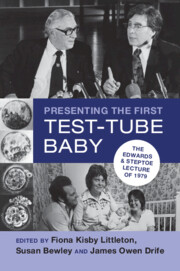Book contents
- Presenting the First Test-Tube Baby
- Presenting the First Test-Tube Baby
- Copyright page
- Contents
- Illustrations
- Tables
- Acknowledgements
- Foreword
- Abbreviations
- 1 Introduction
- 2 From Oldham and Cambridge to the Rest of the World
- 3 The Lecture, 1979
- 4 The Professional Reminiscence, 2019
- 5 The Local Reminiscence
- 6 The Legacy
- Index
- References
3 - The Lecture, 1979
‘Pregnancies Following Implantation of Human Embryos Grown in Culture’
Published online by Cambridge University Press: 23 February 2023
- Presenting the First Test-Tube Baby
- Presenting the First Test-Tube Baby
- Copyright page
- Contents
- Illustrations
- Tables
- Acknowledgements
- Foreword
- Abbreviations
- 1 Introduction
- 2 From Oldham and Cambridge to the Rest of the World
- 3 The Lecture, 1979
- 4 The Professional Reminiscence, 2019
- 5 The Local Reminiscence
- 6 The Legacy
- Index
- References
Summary
This chapter transcribes in full the groundbreaking lecture given by Edwards and Steptoe at the RCOG on 26 January 1979. The historical context is evoked by having the original images of the slides that the lecture spoke to inserted at the places where they were referenced, as they were essential for purposes of illustration. A scholarly set of notes is appended to help readers understand the text from the vantage point of four decades later, citing other relevant medical, scientific, pharmaceutical and biographical work.
Keywords
- Type
- Chapter
- Information
- Presenting the First Test-Tube BabyThe Edwards and Steptoe Lecture of 1979, pp. 48 - 130Publisher: Cambridge University PressPrint publication year: 2023



